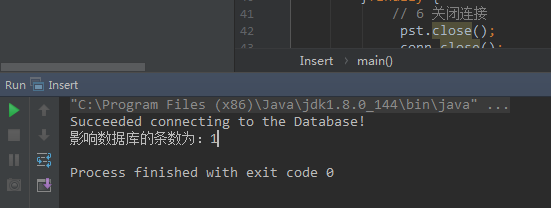package MYSQK; import java.sql.*; /** * PreparedStatement 对象可以对sql语句进行预编译,预编译的信息会存在存储该对象中,当相同的sql语句再次执行时,程序 * 会使用PrepareStatement对象中,而不需再次编译去查询数据库,大大提高了数据的访问效率 */ public class Insert { public static void main(String[] args) throws SQLException{ Connection conn=null; PreparedStatement pst =null; try { // 1 加载驱动类 Class.forName("com.mysql.jdbc.Driver"); // 2 通过DriverManager获取connection对象 String url="jdbc:mysql://192.168.64.128:3306/jdbc?" + "user=root&password=815qza&useUnicode=true&characterEncoding=UTF8"; conn = DriverManager.getConnection(url); if (!conn.isClosed()){ System.out.println("Succeeded connecting to the Database!"); }else{ System.out.println("Sorry,failed connecting to the Database"); } // 3 获取pre对象 String sql = "INSERT INTO USERS(name,PASSWORD,email,birthday) VALUES (?,?,?,?)"; pst = conn.prepareStatement(sql); //为sql参数赋值 pst.setString(1,"bowen5"); pst.setString(2,"815qza"); pst.setString(3,"bowen815@126.com"); pst.setString(4,"1990-11-01"); //4 使用prepare对象执行sql语句 int count = pst.executeUpdate(); System.out.println("影响数据库的条数为:"+count); //5 操作result结果集 }catch (ClassNotFoundException e){ e.printStackTrace(); }finally { // 6 关闭连接 pst.close(); conn.close(); } } }
